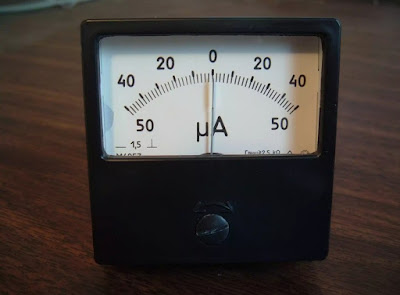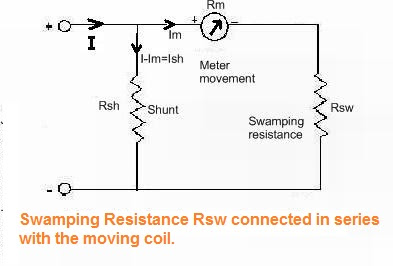Swamping Resistance in Ammeter can be well understood if we investigate the Effect of Temperature change in the Reading of an Ammeter. Ammeter is basically moving Coil instrument and flow of current through the coil decides the deflection of Ammeter. Now if there is change in the temperature then correspondingly there will also be a change in the resistance of the moving coil and shunt resistor used in Ammeter.
Because of the change in current through the moving coil, the reading of Ammeter will not actually represent the actual current flowing in the circuit. One thing we can do is that, we can make shunt resistance and moving coil of the same material, but practically this doesn’t help. This calls for Swamping Resistance.
The arrangement of this method i.e. use of Swamping Resistance is as shown in the figure above. In this method we use a resistance of material having negligible temperature coefficient like Mangnin and this resistance is called as ‘swamping Resistance’. Its resistance is equal to 20 to 30 times the resistance of the coil used in ammeter. The swamping resistance is connected in series with the coil as shown in figure. Since the resistance of moving coil forms a small fraction of the series combination, the proportion in which the currents would divide between the meter and the shunt would not change appreciably with the change in the temperature.
In this manner the effects of change in temperature on ammeters can be minimized.
I am showing one example, which will make it clear that how Swamping Resistance minimizes the effect of temperature change in the Ammeter reading.
Example:
A copper wire moving coil instrument whose resistance is 25 Ohm gives full scale deflection with a current of 1mA. This instrument is to be used with Magnin Shunt to extend its range to 100 mA. Calculate the error caused by a 10 °C rise in temperature when
- Moving coil is deirectly connected across the Magnin Shunt
- A 75 Ohm Swamping Resistance is connected.
Temperature coefficient of copper wire is 0.004/°C and that of magnin 0.00015°C.
Answer:
First we will draw the diagram to make life easier,
Multiplication Factor of Shunt = 100/1 = 100.
Therefore, Resistance of Shunt Rsh = Rm/(m-1)
= 25/99 = 0.2525 ohm.
Case1:
Moving coil resistance for temperature rise of 10 °C will increase. Therefore we need to calculate the rise in the Resistance of moving coil.
Rm10 = Resistance of moving coil for 10 °C rise in temperature
= 25(1+10×0.004) = 26 Ohm.
Similarly,
Rsh10 = 0.2525(1+10×0.00015) = 0.2529 Ohm.
Thus, using current divider law, the current through the moving coil at elevated temperature,
Im10 = (100×0.2529)/(26+0.2529)
= 0.963 mA
But for 100 mA current, there should be a flow of 1 mA current in the moving coil to give full scale deflection. See the effect of temperature rise….
Error in reading = (0.963-1)x100% = -3.7%
Negative sign means that meter will read lower current than that flowing in the circuit.
Case2:
After the insertion of Swamping Resistance,
Total resistance of moving coil, Rm = 25+75 = 100 Ohm
Thus the value of Shunt Resistance Rsh = Rm/(m-1)
= 100/(100-1) = 1.01 Ohm
Rm10 = Resistance of moving coil for 10 °C rise in temperature
= 25(1+10×0.004) + 75(1+10×0.00015) = 101.11 Ohm.
Similarly,
Rsh10 = 1.01(1+10×0.00015) = 1.0115 Ohm.
Thus, using current divider law, the current through the moving coil at elevated temperature,
Im10 = (100×1.0115)/(101.11+1.0115)
= 0.9905 mA
Therefore,
Error in Ammeter Reading = (0.9905-1)x100%
= -0.95%
Thus we see that by using Swamping Resistance of 75 Ohm i.e. 3 times that of moving coil resistance, there is an improvement in the accuracy of Ammeter reading from -3.7% to near about 1%. Thus if we use higher value of Swamping Resistance say 200 Ohm, the accuracy will much more better but it will again increase the voltage across the Ammeter which will make meter less sensitive. This is the disadvantage of higher value of Swamping Resistance.
Thank you!



Nice explanation bro but 1 doubt y can't we manufacture ammeter with swamping wire I mean moving coil with manganin so that additional power loss will be reduced
BEST ONE..
I’MSTUDYING FROM A.K.SHAWNEY BUT FELT IT WAS A BIT INCOMPLETE AND CLEAR EXPLANATION.
YOUR EXPALANATION IS AWESOME..
Thank you! Kindly share the post.